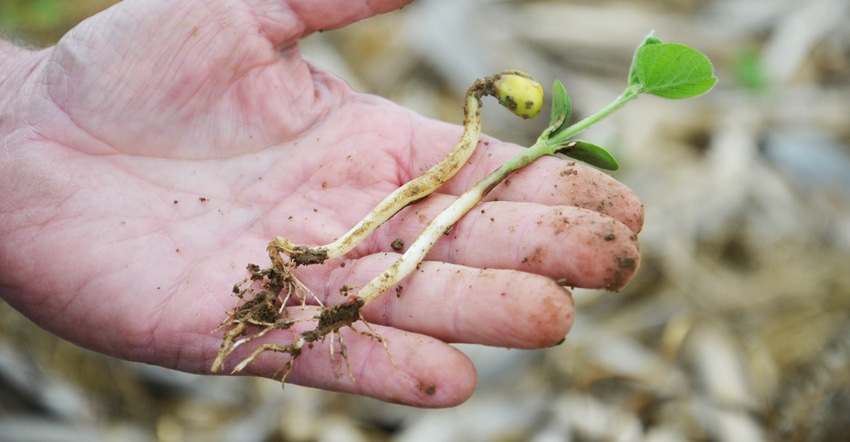
One year ago, there was little to say on this date about the Soybean Watch field. It still wasn’t planted. Where the field was located in central Indiana was cool and wet. The field wasn’t planted until June 6.
This year, the field is again in central Indiana. And not only is it planted, as reported last week, but the soybeans are up, off and running. The cooperator reports that the beans planted in 15-inch rows with a split-row planter have emerged. The Soybean Watch ’18 field was planted on May 5.
Soybean Watch is a project intended to allow farmers to follow reports on how a typical field progresses and any potential problems found there during the season. Hopefully some of what is learned in the Soybean Watch field will apply to your fields and help you know how to deal with what might be happening in your part of the world. Steve Gauck, a Beck’s sales agronomist based in Greensburg, Ind., will visit the plot and provide insight during the season. The Soybean Watch ’18 project is sponsored by Beck’s.
Early scouting
Following the scouting calendar in the 2018 edition of the Purdue University Corn & Soybean Field Guide, here are things Gauck will be looking at in the first part of the season. He is a believer in walking into the field, observing and scouting.
These are things you may want to do and look for in your fields now, too:
• Plant population. The hula-hoop method is a good way to determine a stand count, but you can count plants per so many feet of row, as well. The Purdue guide contains the information you need to turn counts inside a hula-hoop or down the row into populations. Be sure to take counts at various spots selected at random within the field.
• Seed rots and seedling blights. If the crop is out of the ground, you’ve likely escaped seedling rots. If it’s been dry in your area, it may not be a favorable spring for seedling rots anyway. If you notice any problems with seedlings, you may need to refer to the Purdue guide or another source to distinguish between seedling blights or possible herbicide injury.
• Crusting. In the Soybean Watch ’18 field, this danger is past since soybeans have emerged. If you planted conventionally and had a rain, and then it turned hot and dry, crusting could be an issue. Unlike corn, if soybean plants “break their necks” due to pushing through a crust, they are done. Other plants may make it through and compensate.
A couple of irrigation units were running in northern Indiana a few days ago to try to help crops emerge where a rain occurred after planting and crusted the soil. Rotary hoeing may help where you don’t have irrigation.
• Slugs. This may not be a year for slugs since it was warm and dry in most areas in May, the reverse of 2017. Slugs caused a problem in many fields a year ago. Warm weather and plants outgrowing them are the best remedies.
• Bean leaf beetles. You may find feeding from bean leaf beetles on some plants early after they emerge. This generally doesn’t become an issue requiring treatment, but it does indicate that the pest is in the field. There will be a second generation in most cases later in the season.
• Wireworms, grubs and maggots. If the crop is up, you’ve likely escaped these secondary pests as well. They don’t hit every field and aren’t an issue every year. But when they do hit, they can devastate stands in areas or, in severe cases, across whole fields.
About the Author(s)
You May Also Like




